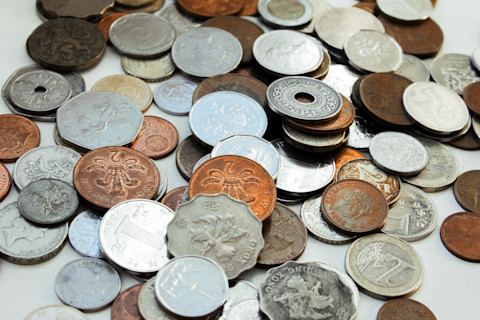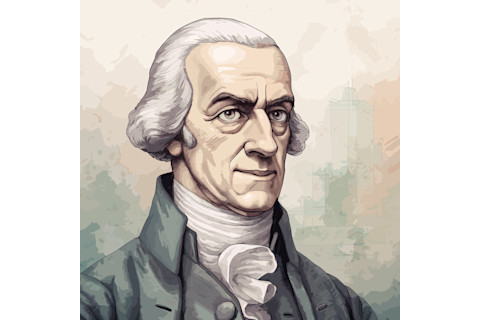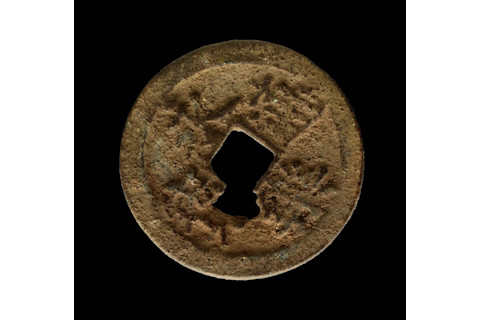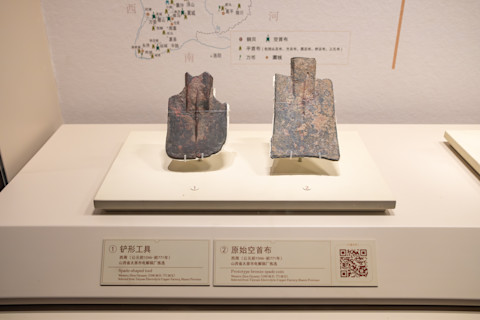Dig into your pockets and pull out some change. If you’re in the U.S., you’ll probably find some crumpled cash and a couple not-so-shiny coins. They may not look like much, but what you’re holding is a handful of history.
Your beaten-up buck is part of the long line of dollar bills printed in the U.S. since 1862. The quarter was introduced in 1796, and the penny appeared three years prior, in 1793. You probably have some in your possession, abandoned at the bottom of your bag.
Of course, the history of human currency stretches far further than the 18th and 19th centuries. As one of the chief underpinnings of human civilization, the use of cash and coins has been ongoing for thousands of years. But when did it start, and what were the world’s first forms of currency?
The Origins of Money

Coins from different countries of the world (Liiiz/shutterstock)
When, where and why money originated is uncertain and complicated. Because ancient civilizations developed at different times and recorded their history with a range of different approaches (some of which were more rigorous or permanent than others), archaeologists and historians can only make best guesses.
In general, though, currency arose a medium of exchange. With its invention, a physical object like a coin or a slip of paper was exchanged for goods and services. Today, many economists insist that currency arose to replace the barter system, in which people traded goods and services directly without money being involved.
Read More: From Barter to Bitcoin: The History of Money
Who Invented Money?

Adam Smith was a pioneer in the thinking of political economy (Credit: ismailyildiz/Shutterstock)
ismailyildiz/Shutterstock
Adam Smith — the 18th-century Scottish economist and philosopher who penned The Wealth of Nations in 1776 — popularized the idea of currency evolving to replace barter. Some modern economic anthropologists, however, reject this claim.
In his 2011 book, Debt: The First 5,000 Years, the late anthropologist David Graeber insisted that there’s not much evidence to support the notion of currency overtaking barter. Instead, Graeber suggested that humans used mediums of account — systems of debt and credit, recorded in objects like ledgers and promissory notes — before coins and cash took over.
British anthropologist Caroline Humphrey reached a similar conclusion in a 1985 paper published by the Royal Anthropological Institute of Great Britain and Ireland. "No example of a barter economy, pure and simple, has ever been described, let alone the emergence from it of money," she wrote. Thus, the arguments for and against 'money from barter’ and 'barter from money,' are convoluted, complex and far from settled, still today.
Regardless of what came first, however, one thing’s for certain: Human beings eventually started using objects as currency, imbuing those objects with immense value.
Read More: The Silk Road Was More Than a Vast Trade Route
What Were the First Currencies?

Chinese shell money from 3,000 years ago. (Credit: PHGCOM, CC BY-SA)
PHGCOM, CC BY-SA
Both shell money (comprised of shells or beads) and commodity money (comprised of objects that have a practical use, like grain) appear to have made up early forms of currency all around the world, from the Indigenous tribes of America to the villages of Africa to the populations of Asia and the South Pacific islands.
Other objects likely used as early forms of currency vary immensely, from bricks of tea and livestock (imagine “The Price Is Right” but with cows) to gems and metal fragments. The oldest known uses of coins as currency, though, can be traced back to ancient China, ancient India and ancient Greece, alongside a couple other archaic civilizations.
Read More: How Money Has Changed Throughout History
When Were Coins Invented?

Chinese coin from early 1400s found in Kenya (Credit: Chapurukha Kusimba)
Chapurukha Kusimba
In China, the first currency took the form of cowrie shells, though these tiny treasures were soon supplemented and swapped for coins made out of metal. Some scholars say that this transition took place in the Spring and Autumn Period, sometime between the 8th century B.C. and the 5th century B.C.
Likewise, in India, the first forays into metal currency were "punch-marked coins," which were made mostly out of silver and stamped with natural shapes and symbols starting in the 6th century B.C.
Around that same time in the 6th century B.C., the ancient Greeks began using the drachma, a coin which was named after the Greek verb meaning “to grasp.” That name makes more sense when one considers that its original value was allegedly equal to a handful of arrows. The drachma continued as a form of currency in modern Greece until 2002, when it was replaced by the Euro.
Other coins from the 6th century B.C. include the silver sigloi (shekel) and the gold daric, which were made between 550 B.C. and 330 B.C. in the Achaemenid Empire, based in modern-day Iran.
Read More: Cosmic Rays Reveal Mystery Chamber From Ancient Greece
Early Turkish Currency: Lydian Stater Coins

The Lydian stater was introduced in the kingdom of Lydia over 2,600 years ago. (Credit: lego 19861111/Shutterstock)
lego 19861111/Shutterstock
Tradition states, however, that the oldest of the old is the Lydian stater. This currency is commonly considered the first minted — or state-produced — coin, issued by King Alyattes in the 7th century B.C. in an area that’s now part of the nation of Turkey. These Lydian coins are made of electrum, a naturally occurring gold and silver alloy.
The coins weren’t very uniform compared to modern coins, often resembling oval or bean-shaped pieces of metal stamped with designs. Minted in the Lydian capital of Sardis, the coins generally featured a lion and bull facing each other — the former of which came to be known as the Lydian Lion.
Like the drachma, deric and shekel, the stater was supposed to conform to a specific standard of size, meaning that the Lydian coins were all of similar weight.
Read More: Snapping the Yak: How an Iconic Photo Ended Up on Nepal's Currency
Ancient Chinese Money: Spade Coins

Two ancient Chinese Spade coins on exhibit at the Shanxi Museum (Credit: Freer/Shutterstock)
Freer/Shutterstock
Up until recently, the Lydian stater's status as the oldest coin was relatively solid. But in August 2021, a study published by Cambridge University Press added weight to the possibility of even older minted coinage.
Excavations of a bronze foundry at Guanzhuang, in China’s Henan Province, revealed clay molds for casting spade coins. The study, conducted by Chinese researchers, indicated that the characteristics of the molds demonstrated the site was likely used as a mint for making standardized coins, and radiocarbon dating indicates that the minting may have begun by around 640 B.C. — the approximate birth year of Lydia’s King Alyattes.
This would make the Chinese foundry, which was situated close to the city's administrative center, the oldest-known coin minting site in the world, with any coins produced there being potentially older than even the Lydian stater. Which currency is truly the oldest is up to additional research to reveal, but the study is certainly clear about this: No matter the specific date of its minting, the money made at Guanzhuang was undeniably old.
Read More: 7 Groundbreaking Ancient Civilizations That Influence Us Today















